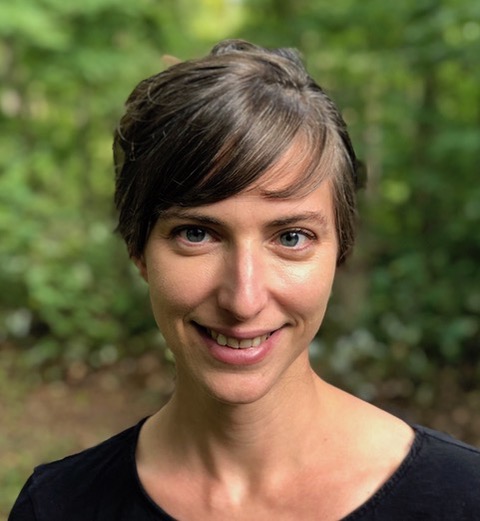Join STUDIO.nano for the next Resonances Lecture!
Lindsay Caplan
Assistant Professor, History of Art & Architecture
Brown University
Date: April 28, 2025
Time: 4:30 PM — 5:30 PM ET
Location: Building 12, Room 0168
Resonances will host a roundtable after the lecture with Prof. Lindsay Caplan; Mark Jarzombek, professor of the History and Theory of Architecture at MIT; and Gediminas Urbonas, associate professor of Art, Culture, and Technology at MIT; moderated by Ardalan SadeghiKivi, STUDIO.nano liaison and lecturer of Comparative Media Studies at MIT, where they will further explore the unique and curious narratives of how science and artistic expression have informed and influenced one another across different domains and modes of cultural production. Following, a reception will be held in the MIT.nano East Lobby.
Analogical Engines—Collaborations across Art and Technology in the 1960s
 This presentation will examine artists working in Europe and the Americas in the 1960s who engage with computers, cybernetics, and early AI. These interdisciplinary activities were more often conceptual than actual: while some artists sought out corporations to gain access to mainframes or collaborate directly with engineers, far more mobilized analogies between humans and machines to reconceptualize the terms with which they worked. Analogies between humans and machine abound in 1960s artistic practice: creativity as algorithmic, style as statistical, perception as pattern recognition, knowledge as information processing, and life as structured by—even equated with—technology.
This presentation will examine artists working in Europe and the Americas in the 1960s who engage with computers, cybernetics, and early AI. These interdisciplinary activities were more often conceptual than actual: while some artists sought out corporations to gain access to mainframes or collaborate directly with engineers, far more mobilized analogies between humans and machines to reconceptualize the terms with which they worked. Analogies between humans and machine abound in 1960s artistic practice: creativity as algorithmic, style as statistical, perception as pattern recognition, knowledge as information processing, and life as structured by—even equated with—technology.
In this talk, Caplan will focus on a central nexus of speculative experiments in simulated existence: the transnational community of artists involved with the Signals Gallery and broadside in London from 1964 to 1966, with particular emphasis on Liliane Lijn. Examining her light sculptures, poem machines, and other abstract artists in the Signals gallery milieu, she will discuss the philosophical and political motivations for collaborations across art, technology, and science and the implications of these historical examples on our technologically mediated existence today.
BIOGRAPHY
 Lindsay Caplan specializes in twentieth and twenty-first century art, with a focus on the intersections of art, technology, and politics. Her first book, Arte Programmata: Freedom, Control, and the Computer in 1960s Italy (University of Minnesota, 2022), examines how early computer artists in Italy deployed new technologies to probe the relationship between subjects and their environment and to explore the nature of human agency, turning artistic questions regarding medium, authorial creativity, and spectatorship to the service of reimagining society in its digital dimensions. The book received a Millard Meiss Publication Grant from the College Art Association and was a Media Ecology Book Awards Finalist.
Lindsay Caplan specializes in twentieth and twenty-first century art, with a focus on the intersections of art, technology, and politics. Her first book, Arte Programmata: Freedom, Control, and the Computer in 1960s Italy (University of Minnesota, 2022), examines how early computer artists in Italy deployed new technologies to probe the relationship between subjects and their environment and to explore the nature of human agency, turning artistic questions regarding medium, authorial creativity, and spectatorship to the service of reimagining society in its digital dimensions. The book received a Millard Meiss Publication Grant from the College Art Association and was a Media Ecology Book Awards Finalist.
Other publications have appeared in exhibition catalogues, edited collections, and journals including Grey Room, ARTMargins, Piano B, The Scholar & Feminist Online, Outland, Art in America, and e-flux journal. Topics include art and labor, the digital humanities, digital art history, and the social concerns that motivated generative artists working in the 1960s and today. She is currently working on two books: a co-edited volume (with Kerry Greaves, University of Copenhagen), Contemporary Art in a Time of Democratic Crisis, which interrogates the idea of modeling democracy in contemporary European art since the 1990s and is under contract with University of Manchester Press. This volume has been awarded two publishing grants from European institutions: the Beckett Foundation and New Carlsberg. Her second book project is a comparative study of artists who use analogies between humans and machines to reimagine creativity and collective life. Looking at Europe and the Americas from the fifties to eighties, it charts a history in which radically destabilized notions of the human were forged at the intersections of art and technology.
Her teaching spans the history of modern and contemporary art and includes courses such as Art and Technology from Futurism to Hacktivism, Abstraction in Theory and Practice, and Dada and Surrealism: Anarchy, Exile, Alterity. In Fall 2023, she taught a Collaborate Humanities Seminar (supported by the Cogut Institute for the Humanities) titled Form and Formalism with Govind Menon, Professor of Applied Mathematics. She is affiliated with the Italian Studies Department.
about the resonances lectures
The Resonances Lectures navigate the intersection of contemporary art, pure and applied sciences, and everyday life. Inaugurated in the Spring of 2025 by STUDIO.nano, this lecture and panel series seeks to gather artists, designers, scientists, engineers, and historians who examined critically how scientific endeavors shape artistic production and vice versa. Their insights expose the historical context on how art and science are made and distributed in society, and offer hints at the possible futures of such productions.
An exploration of the history and present meaning of curiosity, attention, and the urge to know, Resonances shuttles engagingly between rigor and intuition, inviting both the members of MIT community and the general public audience to further engage with and learn from, the past and future of interdisciplinary ideas across vastly different domains and scales.
